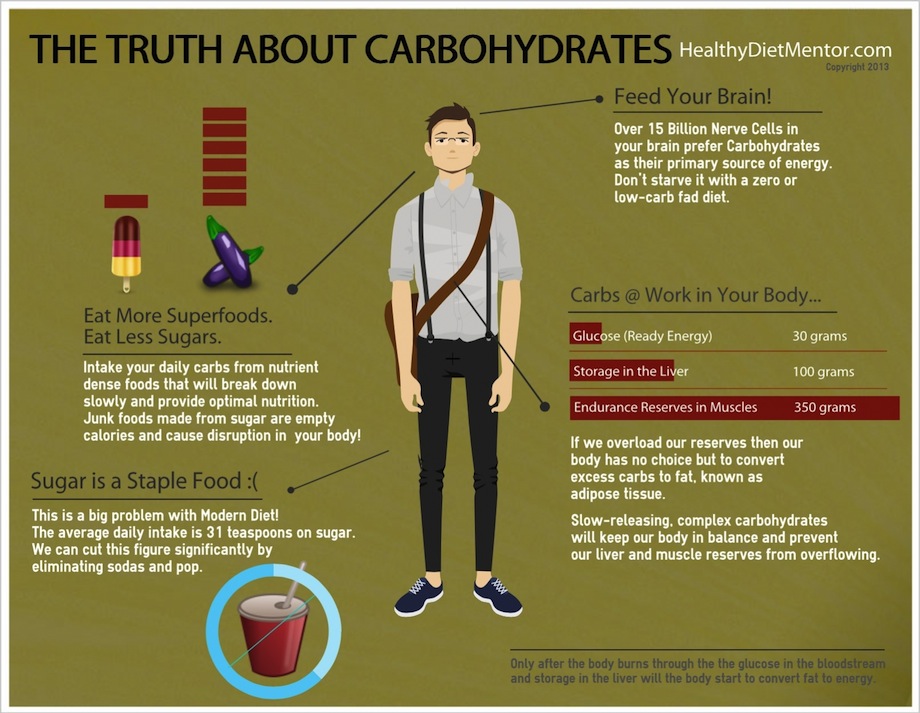{STEP 1.2} What are Carbohydrates?
Let's take a look at this question. What are carbohydrates? Despite popular thought, carbohydrates are the primary source of fuel for your body. They are handled very efficiently in our digestive system and can deliver quick energy to our cells without waste.
As we will learn, using fat or protein for energy requires more work and produces wasteful by-products. The infographic below details some important facts about what are carbohydrates as well as some unfortunate truths of their role in the modern diet.
There are several different types and some are better for us than others. But no matter which kind we eat, all digestible carbohydrates can broken down into glucose, which is the preferred energy source for most of the cells in our body.
Glucose is transported through the bloodstream to the various systems at work in our body that need energy to function properly. Your brain is the most sophisticated and complex organ along with its 15 billion and counting nerve cells that make up your nervous system. All prefer using carbohydrates over other energy sources.
And, yes! You really do need them in your diet!
Unfortunately, fad diet books fail to include this tidbit of information when they tell you to deprive your body of much needed nutrients to lose a few pounds in the short term. Carbohydrates are actually the most prominent energy-yielding nutrient among a majority of natural, whole foods.
A healthy diet always includes carbohydrates to fuel your brain and body!
You Still Need to Eat the Right Type of Carbs to Get Results.
Now that we know what are carbohydrates and some truths about them, let's find out which are better for our body and why!
We'll call one group Simple and the other group Complex.
Simple carbohydrates are sugars. These are the same sugars referenced on the food nutrition labels, but not to be confused with white table sugar. Of the six sugar molecules that are important in nutrition, there are two that you should know.
Glucose is the first and we touched on its importance already. All carbohydrates that your body digests end up as this molecule. Glucose is then broken down within cells after being transported through the bloodstream and results in the creation of efficient energy.
Sucrose is the molecule we know as table sugar. It's found in sugarcane, sugar beets, honey, and maple sugar but most commonly seen refined as white granules. As you might expect, sucrose gets broken down into glucose once inside the body but we need to be aware of it in our diet. Why?
Table sugar consumption is in our diets is higher than anytime in history. Some studies estimate the US average added sugar intake is 31 teaspoons a day, which translates to approximately 520 Calories (kcal) of the diet coming from sugar alone!
Complex carbohydrates are starches. These large groups of glucose are bonded together in chains. Humans can digest two basic forms. The first is a long, straight chain called amylose. Its close relative amylopectin is more sophisticated with many branches.
Fiber is a special type of complex carbohydrate.
Including it is part of your healthy diet plan, but it does not yield direct energy for the body so we will dedicate a separate area to it. Let's continue learning what are carbohydrates...
Even though starches can consist of more than 1000 glucose molecules, they too will be broken down into single units for energy use. This brings up a fundamental question, what happens if we eat more carbs than our body needs for energy?
Glycogen is a starch that provides the answer this question. After you eat, enzymes in your digestive system begin to break down the nutrients. As the amount of glucose in your blood begins to rise, a hormone called insulin is released by the pancreas and acts a messenger for your body. It directs cells to remove glucose from the bloodstream and tells your liver and muscles to get ready to help store the excess.
|
|
All Things Related to Carbs |
Let's Make Sense of All this Info on What are Carbohydrates.
We now know that by taking in carbohydrates, our body will use some of the glucose produced to fuel its cells and systems by transporting it through the bloodstream. Approximately 120 Calories of glucose are available within the bloodstream at any given time.
We also know that excess glucose is removed from the blood and stored in the liver or muscles in the form of glycogen, a highly-branched starch for use at a later time. The liver can store an additional 400 Calories to help raise blood glucose levels almost immediately. Muscles are capable of storing a whopping 1400 Calories of glycogen stores but unfortunately use the energy storage for endurance and/or high intensity activity.
Starches with more complex branching structures allow the digestive enzymes can break it down into glucose molecules at a faster pace. The faster the glucose arrives in the bloodstream, the greater the response by insulin to store it as glycogen for back-up energy.
Once these storage sites are filled to capacity the body will begin to burn more glucose rather than fat as a last resort. However, if glucose continues to enter the bloodstream fat cells will then start the process of storing energy. Their potential, as we will learn when start talking about lipids, is essentially limitless. This snowballing process leads us to one key concept for your health and well-being.
Regulating the amount of glucose in your bloodstream is a key to component to understanding what are carbohydrates and how they work in your healthy diet puzzle!
How Do I Self-Regulate My Blood Glucose Level?
Simple carbohydrates enter the bloodstream almost immediately. Enzymes break them down very quickly because they are so small in comparison to starches. If your meal contains a high amount of sugars, then your blood glucose level will rise very rapidly.
From a nutrient-relevant viewpoint, sugars only provide energy in the form of glucose. We will often refer to simple carbohydrates as empty calories. This means they provide little to no addiitional nutrients for your body.
A healthy diet is based on eating nutrient-rich foods and minimizing added sugars.
By eating more complex carbohydrates we can give our body the opportunity to run at maximum efficiency. They will take longer to breakdown and release into the bloodstream at a steady rate, providing you with consistent energy while giving other systems in body a break from working too hard.
Scientists developed a tool known as the glycemic index to help us determine which foods will elevate our blood glucose levels faster than others. It is influenced by starch structure, fiber content, food processing, physical structure, and other nutrients in the food. This not only separates the sugars from the starches, but tells us which starches are better than others and highlights imposture foods.
After we find the first puzzle piece, we will be begin to create your healthy diet plan and start to utilize the glycemic index and other tools to help you succeed. But for now, let's continue on our path to becoming nutrition gurus...
Action Steps
|
 |
Read these articles to get a basic understanding of the concepts...
- Benefits of a Healthy Diet: Reasons to Change Your Life for the Better
- What are Carbohydrates and Do You Really Need Them?
- What are Lipids and Are They as Scary as They Sound?
- What is Protein and How Does My Body Actually Use It?
- What is Fiber and Why is It So Important to a Healthy Diet?
- What are Vitamins? For Starters... They're Essential Nutrients
- What is a Healthy Diet? Its Core Components Explained
**As always, feel free to use the navigation below to backtrack and get an overview of Healthy Diet Mentor and our plan to get you on your way to a lifelong healthy diet.
